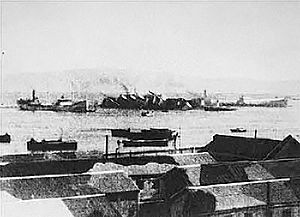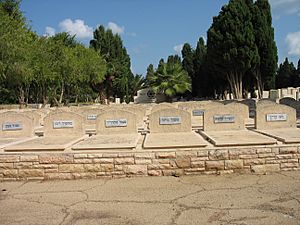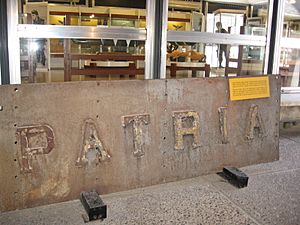Patria disaster facts for kids
The Patria disaster was when a large ship called the SS Patria sank in the port of Haifa. This happened on November 25, 1940. A Jewish group called the Haganah caused the sinking. Sadly, 267 people died, and 172 were hurt.
At the time, the Patria was carrying about 1,800 Jewish people. These people were refugees from parts of Europe controlled by Nazi Germany. The British authorities were sending them away from Mandatory Palestine to Mauritius. This was because the refugees did not have permission to enter Palestine. Jewish groups like the Zionists did not want the refugees to be deported. So, the secret Haganah group planted a bomb. They wanted to damage the ship so it could not leave Haifa.
The Haganah later said they made a mistake. They thought the bomb would only disable the ship. Instead, the explosion blew a big hole in the ship's side. The ship sank very quickly, in less than 16 minutes. Many people were trapped inside. Because of this tragedy, the British allowed the people who survived to stay in Palestine. For many years, people did not know who was truly responsible for the sinking. This mystery was solved in 1957. That's when Munya Mardor, the person who planted the bomb, wrote a book about what happened.
Contents
Why the Patria Sank: The Background
Before 1941, the government of Nazi Germany allowed Jewish people to leave Europe. This was before they decided to try and kill all Jews in Europe. Jewish groups tried to help Jews get from Europe to Palestine. They did this even though it was against the immigration rules set by the British government.
These efforts sometimes involved working with Nazi officials. The Nazis saw this as a way to cause problems for Britain and get rid of Jews. A group called the Zentralstelle für jüdische Auswanderung (Central Office for Jewish Emigration) helped organize Jewish people leaving Nazi-controlled areas. In September 1940, this group rented three ships: the SS Pacific, SS Milos, and SS Atlantic. These ships were meant to take Jewish refugees from Romania to Palestine. About 3,600 refugees from cities like Vienna and Prague were on board.
The Pacific arrived near Palestine on November 1, and the Milos arrived a few days later. The Royal Navy stopped these ships and took them to Haifa port. The British government already knew the ships were coming. They decided not to let the immigrants enter Palestine. The British felt it was safer to upset the Jewish community than to risk an Arab uprising. They wanted to make an example so other refugees would not try to come.
On November 20, Sir Harold MacMichael, the British High Commissioner for Palestine, ordered the refugees to be sent away. They were to go to Mauritius, an island in the Indian Ocean, and Trinidad in the Caribbean.
The refugees were moved to another ship, the SS Patria, for the trip to Mauritius. The Patria was a large ship built in 1913. It used to carry passengers between Marseille and the Middle East. It had arrived in the Port of Haifa just before Italy declared war on France and Britain. It stayed in port for safety. After France surrendered to Nazi Germany, the British took control of the Patria. They planned to use it as a troop ship. As a passenger ship, it could carry 805 people. But for troops, it could carry 1,800. However, it still only had enough lifeboats for the original 805 people. So, extra liferafts were added.
The refugees from the Pacific and Milos were quickly moved to the Patria. The Atlantic arrived on November 24, and about 800 of its 1,645 passengers also started to move to the Patria.
The Bombing of the Patria
While this was happening, Jewish groups were trying to stop the deportation plan. A general strike did not work well. Another group called the Irgun tried to put a bomb on the Patria, but they failed. The Haganah also wanted to disable the Patria. Their goal was to make the ship stay in port for repairs. This would give them more time to convince the British to change their minds. Yitzhak Sadeh was the Haganah officer in charge. He was given permission by Moshe Sharett, who was leading the Jewish Agency's Political Department at the time.
On November 22, Haganah agents secretly put a small bomb (2 kilograms) on the ship. It was set to explode that evening, but it did not work. So, on November 24, a second, more powerful bomb was secretly placed near the ship's inner wall. At 9 a.m. on November 25, the bomb exploded. The Haganah had miscalculated how powerful the bomb would be. It blew a large hole, about 3 by 2 meters (10 by 7 feet), in the ship's side. The ship sank in just 16 minutes.
When the bomb exploded, the Patria had 1,770 refugees from the Pacific and Milos. It also had 134 passengers from the Atlantic. Most people were saved by British and Arab boats that quickly came to help. However, 267 people were reported missing. This included over 200 Jewish refugees, plus about 50 crew members and British soldiers. Another 172 people were injured. Many of those who died were trapped in the Patria's lower decks and could not escape as the ship quickly rolled over and sank. Later, 209 bodies were found and buried in Haifa.
What Happened After the Sinking
The refugees who survived the Patria sinking, along with the remaining 1,560 passengers from the Atlantic, were taken to the Atlit detainee camp. Later, after many people around the world spoke up, the Patria survivors were allowed to stay in Palestine. However, the other Atlantic passengers were sent to Mauritius on December 9. After World War II ended, they were given a choice of where to go. Most (81%) chose to go to Palestine and arrived there in August 1945.
In December 1945, a newspaper called Ha-Po'el ha-Tza'ir ("Young Worker") wrote about the event. It said, "On one bitter and impetuous day, a malicious hand sank the ship." The writer, Israel Cohen, did not know that leaders of his own political party, Mapai, were responsible. Some Haganah leaders were angry about the newspaper's comment. They sent Ben-Gurion's son, Amos, to the newspaper office. He slapped the editor, Isaac Lofven.
There was a strong, secret debate among the Zionist leaders about whether the bombing was the right thing to do. An active group had made the decision without asking more moderate members, which was not the usual way. This caused serious disagreements that lasted for many years. Some tried to make the incident a symbol of Zionist strength, but this did not really work. As early as December 15, 1945, Isaac Lofven warned a meeting against trying to "sanctify" the tragedy.
Some leaders of the Yishuv (the Jewish community in Palestine) said that the lives lost were not in vain. They pointed out that the Patria's survivors were allowed to stay in the country. Others said that the Haganah had no right to risk the lives of the immigrants. They argued that the immigrants had not chosen to be part of the secret Jewish fight against the British.
The Haganah's role in the sinking was not told to the public for a long time. A story was spread that the refugees, feeling hopeless, had sunk the ship themselves. For years, Britain thought another group, the Irgun, was probably responsible.
The Haganah's role was finally made public in 1957. This was when Munya Mardor, the person who planted the bomb, wrote about his experiences in the Jewish underground. He said, "There was never any intent to cause the ship to sink. The British would have used this against the Jewish population and show it as an act of sabotage against the war effort." He explained that the Haganah wanted to fight the British rules and that their main goal was to avoid anyone getting hurt. The British said 267 people died. But the Jewish Agency and the Haganah could not confirm exactly how many people escaped and how many died.
Munya Mardor continued to work at the port to avoid suspicion. The Haganah also started an investigation. They wanted to find out why such a small amount of explosives caused such a big hole in the ship. The Haganah investigators concluded that the ship's structure was old and weak. This meant it could not handle the force of the explosion.
Rudolf Hirsch, a Jewish-German writer, later wrote a novel about the incident called Patria Israel. In his book, he also mentioned Mardor's account.
See also
 In Spanish: Atentado del SS Patria para niños
In Spanish: Atentado del SS Patria para niños
- Aliyah Bet
- SS Exodus
- SS Ocean Vigour
- Struma disaster




